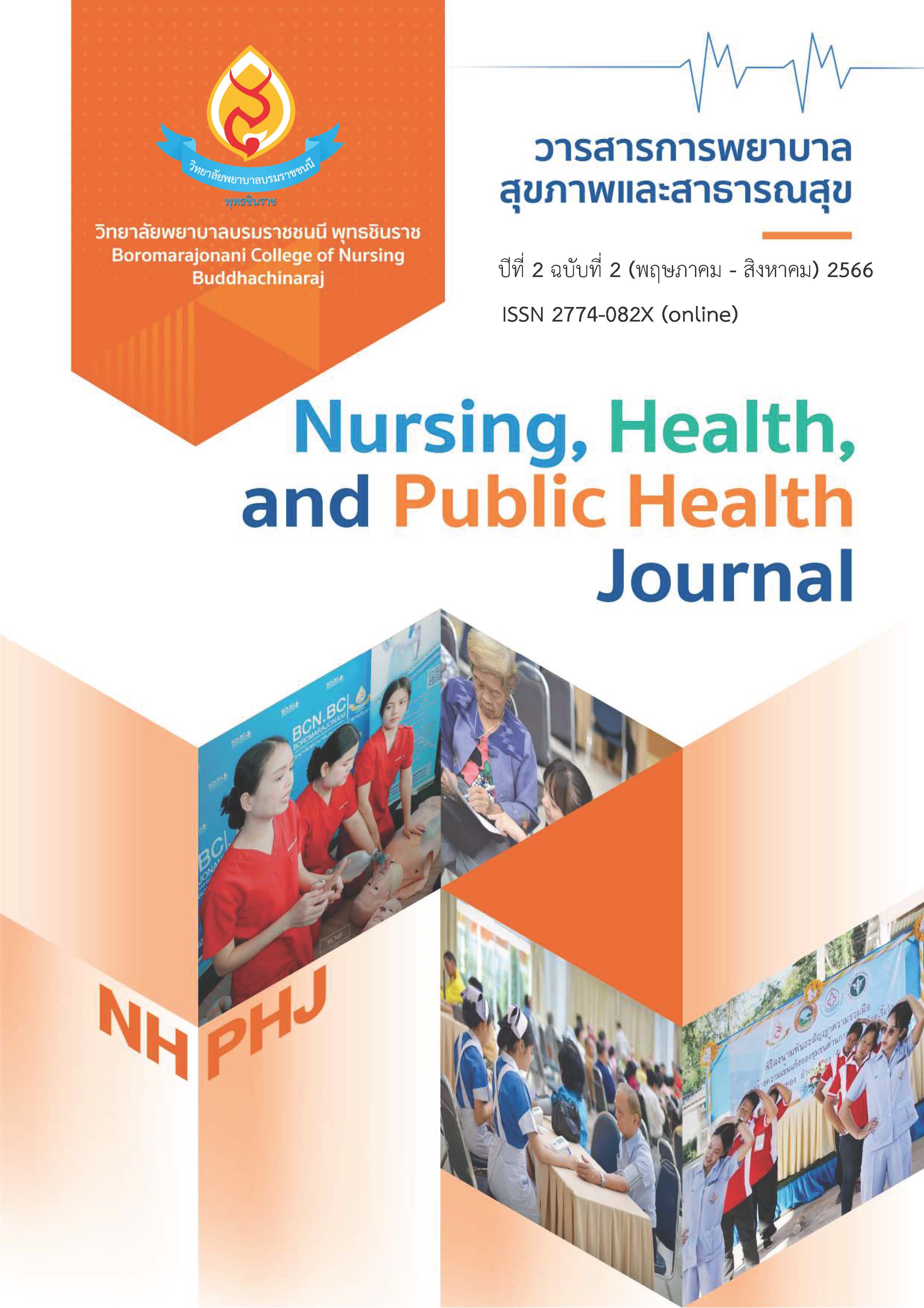The effect of using rubber tubes on pressure sores at auricle grooves among intubated patients with bandage securing tube
Keywords:
rubber tube, pressure sores on ear canal groove, intubation bindingAbstract
This quasi - experimental research aims to compare the incidence of pressure ulcers in the ear canal groove between intubated patients receiving the use of rubber tubing as an ear protector and intubated patients using gauze as an ear protector. These patients are those who have undergone endotracheal intubation for respiratory support in the Medicine Intensive Care Unit 1, Buddhachinaraj Hospital Phitsanulok. The study was a two - group posttest-only design study. The sample was patients who had received endotracheal intubation for respiratory support. A purposive sampling method was used to select a specific 60 intubated patients. These participants were divided into two groups: an experimental group using rubber tubing as an ear protector and a control group using the traditional gauze ear protector. The tool used in the experiment was rubber tubing as an ear protector. Data collection instruments were patient data record forms and a satisfaction questionnaire for nurses. The validity of these tools was assessed by three qualified individuals, with content validity index (CVI) = 0.80 and 0.82. The reliability of these tools was determined using Cronbach's alpha = 0.82 and 0.85, respectively. The general data were analyzed by using descriptive statistics, including percentages, mean values, and standard deviations. Then, compare the differences in pressure ulcer occurrence in the ear canal groove and the number of days until pressure ulcer development between the experimental and control groups using the Chi-square test and Fisher's exact test.
The study found that the occurrence of pressure ulcers at the ear canal groove and the number of days it took for the ulcers to develop after using rubber tubing and the group who received gauze differed significantly (p<0.001). However, there was no significant difference in the occurrence of pressure ulcers at the ear canal groove between the two groups on days 4 - 7 and beyond 7 days. The satisfaction level of nurses was high (Mean = 4.12, S.D. = 0.74).
The findings of this study can be further applied to reduce pressure from medical devices in other positions to ensure patient safety and quality care in the future.
References
กองการพยาบาล สำนักงานปลัดกระทรวงสาธารณสุข. (2562). การประเมินคุณภาพการพยาบาลในโรงพยาบาล กระทรวงสาธารณสุข. ปทุมธานี: บริษัท สำนักพิมพ์สื่อตะวันจำกัด.
กัลยา วานิชย์บัญชา. (2540). การวิเคราะห์สถิติ (พิมพ์ครั้งที่ 3): สถิติเพื่อการตัดสินใจ, จุฬาลงกรณ์ มหาวิทยาลัย.
จุฬาพร ประสังสิต, กาญจนา รุ่งแสงจันทร์, วรรณิภา อำนาจวิชญกุล, ปนัดดา เสือหรุ่น, วาริดา จงธรรม, และ ละมัย โมรา. (2561). Siriraj concurrent trigger tool by modified early warning sign for pressure injury prevention. https://repository.li.mahidol.ac.th/handle/123456789/62235.
เครือวัลย์ ปานอิน, ธนลวรรณ แก้วลูน, ลดาวัลย์ ภีระคำ, สังวาล หาญฟ้างาม, และ นุชจรี รัตนเสถียน. (2563). ผลการใช้นวัตกรรมหมอนอุ้มหูในการลดการเกิดแผลกดทับบริเวณใบหูในผู้ป่วยวิกฤติโรคหลอดเลือดสมอง. ใน การประชุมวิชาการ MED CMU Quality Fair ครั้งที่ 1 ประจำปี 2563 คณะแพทย์ศาสตร์มหาวิทยาลัยเชียงใหม่. มหาวิทยาลัยเชียงใหม่
ปราณี อินทพันธ์. (2558). การเพิ่มประสิทธิภาพการผูกยึดท่อช่วยหายใจทางปาก. http://www.si.mahidol.ac.th/km/sites/all/modules/pubdlcnt/pubdlcnt.php?file=/km/sites/default/files/u1/02_0.pdf&nid=3603
ผกามาศ พีธรากร. (2564). การพยาบาลผู้ป่วยที่มีแผลกดทับโดยใช้หลักฐานเชิงประจักษ์: บทบาทพยาบาล. หัวหินเวชสาร, 1(1), 1-16.
พรศิริ เรือนสว่าง, เพ็ญพิมพ์ ขันทอง, ณัฐนันท์ หาญณรงค์, ธัณฐภรณ์ กอสกุลศิริบูรณ์, และ อรุณรัตน์ เพิ่มผล. (2557). การจัดทำแนวปฏิบัติเพื่อป้องกันและการดูแลแผลกดทับในสถาบันบำราศนราดูร. วารสารสถาบันบำราศนราดูร, 8(3), 1-11.
โรงพยาบาลพุทธชินราช พิษณุโลก. (2561). สถิติบริการ โรงพยาบาลพุทธชินราช พิษณุโลก. โรงพยาบาลพุทธชินราช พิษณุโลก.
โรงพยาบาลพุทธชินราช พิษณุโลก. (2562). สถิติบริการ โรงพยาบาลพุทธชินราช พิษณุโลก. โรงพยาบาลพุทธชินราช พิษณุโลก.
ศรีจันทร์ พรจิราศิลป์. (2557). ความเครียดและวิธีแก้ความเครียด. https://pharmacy.mahidol.ac.th/en/knowledge/article/47/ความเครียด-วิธีแก้ความเครียด.
Ayello, E. A., Zulkowski, K., Capezuti, E., Jicman, W. H., & Sibbald, R. G. (2017). Educating nurses in the United States about pressure injuries. Advances in skin & wound care, 30(2), 83–94. https://doi.org/10.1097/01.ASW.0000511507.43366.a1
Barakat-Johnson, M., Barnett, C., Wand, T., & White, K. (2017). Medical device-related pressure injuries: An exploratory descriptive study in an acute tertiary hospital in Australia. Journal of Tissue Viability, 26(4), 246-253. https://doi.org/10.1016/j.jtv.2017.09.008.
Bernard, H.R. (2011). Research methods in anthropology: qualitative and quantitative approaches. Rowman Altamira, Lanham, Maryland.
Black, J., Alves, P., Brindle, C. T., Dealey, C., Santamaria, N., Call, E., & Clark, M. (2015). Use of wound dressings to enhance prevention of pressure ulcers caused by medical devices. International Wound Journal, 12(3), 322-327. https://doi.org/10.1111/iwj.12111
Li, Z., Lin, F., Thalib, L., & Chaboyer, W. (2020). Global prevalence and incidence of pressure injuries in hospitalised adult patients: A systematic review and meta-analysis. International journal of nursing studies, 105, 103546. https://doi.org/10.1016/j.ijnurstu.2020.103546
National Pressure Ulcer Advisory Panel (NPUAP). (2018). NPUAP Pressure ulcer stages. https://journals.lww.com/aswcjournal/Citation/05000/National_Pressure_Ulcer_Advisory_Panel_s_Updated.12.aspx
Srikasem, B., & Kungeena, O. (2018). The development of a clinical supervision model related the patient’s pressure ulcer. Rajavithi Hospital. Journal of Nursing Division, 45(1), 9-23.
Usher, K., Woods, C., Brown, J., Power, T., Lea, J., Hutchinson, M., Mather, C., Miller, A., Saunders, A., Mills, J., Zhao, L., Yates, K., Bodak, M., Southern, J., & Jackson, D. (2018). Australian nursing students' knowledge and attitudes towards pressure injury prevention: A cross-sectional study. International journal of nursing studies, 81, 14–20. https://doi.org/10.1016/j.ijnurstu.2018.01.015
Downloads
Published
How to Cite
Issue
Section
License
Copyright (c) 2023 Boromarajonani College of Nursing Buddhachinaraj

This work is licensed under a Creative Commons Attribution-NonCommercial-NoDerivatives 4.0 International License.



